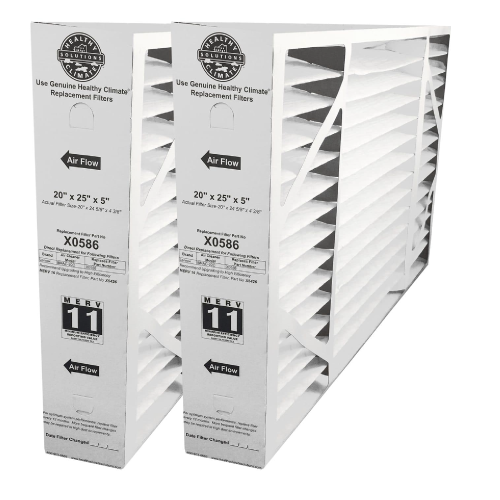
May 2024
By: Josh Walejewski
Read Time: 3 Minutes
In celebration of Clean Air Month, we’re conducting an in-depth analysis of the relationship between indoor air quality and its impact during work. With the rise of remote and hybrid work models, our work environments have expanded beyond traditional office spaces. Nonetheless, the importance of indoor air quality remains universally relevant.
Regardless of where you work, we spend an average of 2080 hours a year in our work environments. This raises a crucial question. What role does indoor air quality play in our productivity, cognitive ability, health, and wellness during working hours and why is it so important?
What is Indoor Air Quality?
Indoor air quality (IAQ) refers to the condition of the air within buildings and structures. Especially as it relates to the health and well-being of those inside it. IAQ is determined by measuring the concentrations of pollutants, humidity levels, temperature, and ventilation/air exchange rates.
Good indoor air quality is characterized by low levels of pollutants, adequate ventilation, comfortable temperatures, and optimal humidity levels. Ideal IAQ contributes positively to the well-being and productivity of individuals.
Symptoms of Poor Indoor Air Quality
While poor indoor air quality might not be visible, it can certainly be felt. The EPA reports that poor IAQ can lead to a range of health issues. The most common symptoms of low IAQ include respiratory problems, allergies, fatigue, and headaches.
However, poor IAQ also impacts our mental health. Prolonged exposure to poor IAQ can lead to increased stress and anxiety levels, decreased cognitive ability, and reduced mood/attitudes.
How does IAQ Impact workplace performance?
Cognitive Ability
A 2021 study by Harvard University’s T.H. Chan School of Public Health reveals a direct correlation between indoor air quality and cognitive performance in the workplace. Conducted over a 12-month period, the study involved monitoring the real-time indoor air quality for more than 300 office workers. Participants were subjected to random daily cognitive tests throughout the study period.
The findings indicated that during periods of poor IAQ, employees took longer to complete tests and answered fewer answers correctly. Overall, cognitive performance declined significantly when IAQ was suboptimal.
Employee Absenteeism
 Symptoms stemming from poor IAQ can be easily misconstrued as being sick. The term Sick Building Syndrome has even been coined to describe this phenomenon. Sick Building Syndrome (SBS) refers to a condition where building occupants suffer from acute health or comfort issues that appear to be connected to time spent within the building, yet no specific illness or cause can be identified. There is mounting evidence that improving IAQ can lead to a significant reduction in employee absenteeism.
Symptoms stemming from poor IAQ can be easily misconstrued as being sick. The term Sick Building Syndrome has even been coined to describe this phenomenon. Sick Building Syndrome (SBS) refers to a condition where building occupants suffer from acute health or comfort issues that appear to be connected to time spent within the building, yet no specific illness or cause can be identified. There is mounting evidence that improving IAQ can lead to a significant reduction in employee absenteeism.
A study from the National Research Council of Canada found that one-third of employee sick time is attributed to symptoms caused or aggravated by poor IAQ. This is further supported by a Massachusetts study that noted 35% less sick leave in offices with optimal IAQ compared to those with low IAQ.
What Can Be Done to Improve Indoor Air Quality in Our Workplaces?
Enhance Ventilation
Did you know on average, indoor air is 2-5 times more polluted than outdoor air? Increasing the rate of air exchange in a building can significantly dilute pollutants. This can be achieved by adding additional components to your HVAC system such as a Heat Recovery Ventilator (HRV) or Fresh Air Intake. If weather permits, opening a few windows to let fresh air in also helps improve air exchange.
In case you missed it, click here to view our May 2023 blog on using fresh air for a healthier home.
Optimize Humidity Levels
Keeping humidity levels in check (between 30% and 50%) can help prevent the growth of mold and dust mites, both of which can degrade IAQ. Additionally, when relative humidity is outside the optimal range, we become more susceptible to catching viruses. Cold and flu viruses have been linked to speedier progression and transmission in air that is too humid or too dry.

Select a Filter with a High MERV Rating
Not all air filters are created equally. One of the most direct ways to enhance indoor air quality is by selecting the appropriate air filters for your HVAC system. The efficiency of an air filter is measured by its Minimum Efficiency Reporting Value (MERV). MERV ratings range from 1 to 16, with higher numbers indicating a filter’s ability to capture smaller particles.
The ideal MERV rating for most workspaces is between 11 and 13. Filters in this range provide a high level of filtration, capturing smaller particulates that can trigger allergies and other respiratory symptoms. Want to learn more about air filters and MERV ratings? Click here to view the Ultimate Air Filter Guide
Germicidal and UV Lights
Germicidal and UV lights target and neutralize airborne pathogens, including bacteria, viruses, and mold spores. These systems utilize ultraviolet (UV) light, particularly UV-C, which nullifies microorganisms by damaging their DNA or RNA, rendering them harmless and unable to reproduce.
Germicidal UV lights are installed into a building’s HVAC system and continuously purifies indoor air as it recirculates. This technology not only helps in maintaining a healthier environment for improved employee productivity but also reduces absenteeism by mitigating the spread of infectious diseases and viruses.
Final Thoughts
As we observe Clean Air Month, it’s clear that the quality of the air in our workplace is not just a matter of comfort—it’s a crucial component of our well-being and productivity. Whether working in traditional office settings or from home, the steps we take to enhance indoor air quality can have profound effects on our cognitive abilities, health, and overall workplace satisfaction.
We encourage all businesses and employees to consider these improvements not as optional upgrades, but as essential investments in their team’s success. Remember, when it comes to indoor air quality, even small investments can have significant impacts.
Read more blog posts from Kettle Moraine Heating & AC.
About the Author
Josh Walejewski
Josh is a professional marketer who has worked in the HVAC industry since 2017. With a Bachelor of Applied Arts and Sciences Degree (B.A.A.S) in marketing and sustainable business management from the University of Wisconsin, he has a passion for all aspects of HVAC, business, marketing, and environmental stewardship.





